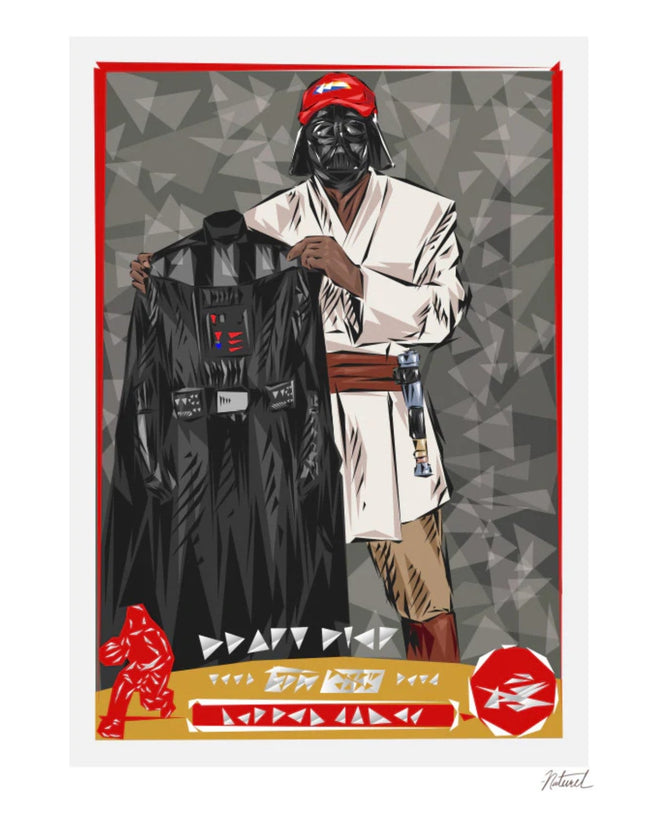
Villain

Naturel- Lawrence Atoigue Darth Bron Archival Print by Naturel- Lawrence Atoigue
Darth Bron Archival Pigment Fine Art Limited Edition Print on 340gsm Cold Press Natural Paper by Artist Naturel, Street Pop Art Graffiti Legend. 2022 Signed Limited Edition of 100 Size 13.5x19 Naturel's "Darth Bron" - A Cultural Synthesis on Canvas Within the ever-evolving sphere of Street Pop Art and Graffiti Artwork, artist Naturel stands out with his work "Darth Bron," a limited edition fine art print that encapsulates the fusion of popular culture and high art. In this 2022 signed limited edition of 100, measuring 13.5x19 inches, Naturel presents an iconic image rich in cultural references and artistic merit. Crafted on 340gsm Cold Press Natural Paper, the print boasts a quality that resonates with collectors and enthusiasts alike. The artwork is a fine example of the cross-pollination of street-style aesthetics with classical art techniques, a characteristic that defines Naturel's place in the art world. Lawrence Atoigue, professionally known as Naturel, hails from the United States. His work is a testament to his ability to blend contemporary subjects with a classical sense of composition and technique. "Darth Bron" showcases this blend in a vibrant display of geometric shapes and bold lines, portraying a thematic juxtaposition that has captured the attention of the global art community. A Visual Dialogue Between Modern Mythology and Sport "Darth Bron" is a striking piece that stands at the crossroads of modern mythology and the world of sports. Here, Naturel explores the conceptual likeness between the mythic figure of Darth Vader from the iconic Star Wars saga and the athletic prowess of LeBron James, a contemporary basketball legend. The artwork cleverly plays with the concept of identity and role, depicted through the portrayal of a cloaked figure presenting a basketball jersey. This image challenges and engages the viewer to decipher its multiple layers of meaning. This piece captures the zeitgeist by merging the timeless allure of a sci-fi character with the contemporary glory of a sports hero. It's a narrative of power, transformation, and identity that resonates with a broad audience. The artistry lies not just in the bold subject matter but also in the meticulous technique: archival pigment on fine art paper ensures longevity and depth of color, allowing the work to stand the test of time physically and thematically. Naturel's Technique and Influence Naturel's approach to art combines the immediacy and boldness of street art with the sophistication of fine art printing techniques. His use of cold press paper imbues the work with a textural depth that complements the visual complexity of his designs. The geometric abstraction and sharp lines are signature elements that contribute to the distinctive quality of his art. These elements merge to form a unique visual language that speaks to the dynamism of street culture while being rooted in a tradition of meticulous craftsmanship. Naturel's influence extends beyond the canvas; his work is a dialogue with popular culture, reflecting and shaping the narratives that define contemporary society. "Darth Bron" is not merely a static representation; it's an active participant in the cultural conversation. Through this print, Naturel contributes to the evolving story of how art interacts with and comments on popular media, societal values, and the human experience. In a world where visual culture is increasingly prominent, Naturel's "Darth Bron" serves as both an homage to and a critique of the icons that dominate our collective consciousness. His work encourages us to reflect on the figures we idolize, the stories we hold dear, and the values they represent. It's a testament to the power of Street Pop Art and Graffiti Artwork as platforms for commentary, expression, and artistic innovation. Naturel continues to inspire and provoke with his art, ensuring his place in the pantheon of artists who seamlessly bridge the gap between the gallery and the street.
$322.00


